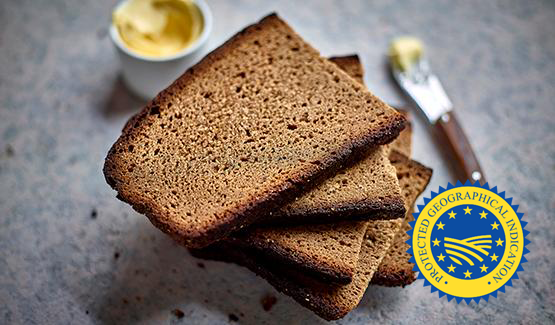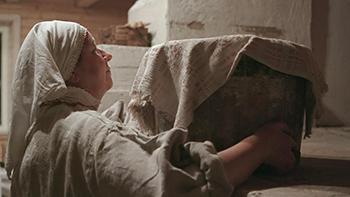A dark and delicate rye bread, Daujėnų naminė duona PGI has been produced in the north Lithuanian village of Daujėnai for centuries.
Each loaf is home-made, bearing a taste and tradition that has been shaped by generations of family bakers.

Origins
The name Daujėnų naminė duona (“home-made bread of Daujėnai”) captures the humble origins of this traditional variety of bread.
The custom of baking rye bread in the village of Daujėnai stretches back to at least the 17th century. Every loaf was made in family homes, using recipes and methods maintained by the generations of women that ran the households.
As well as passing on skills and knowledge, traditional bread-making utensils were also handed down, including millstones for grinding grain, oak troughs for kneading and fermenting dough, and clay bread ovens for baking. Each family kept its own oak trough, imbued with residual bread acid from past batches. By keeping and reusing troughs within their respective households, families ensured that the same acid and flavours were retained over the years.
While every family baked bread for its own everyday needs, highly ornate loaves were also prepared as centrepieces of feasts and festivities such as weddings, christenings and anniversaries, acting as symbols of family strength, fidelity, fertility and humility.
Towards the end of the twentieth century, the reputation of the rye bread from Daujėnai spread and production increased to meet rising demand. The product began to appear in exhibitions and trade fairs across Lithuania and beyond, accumulating numerous prizes and accolades.
Despite its growth in popularity, the production of Daujėnų naminė duona has never left the confines of household kitchens. Today’s loaves are still made at home by descendants of the same families who baked batches from one generation to the next.
In recognition of its homemade qualities and heritage, Daujėnų naminė duona was added to the list of protected geographical indication products of the European Union in 2014.
Production
All steps in the production of Daujėnų naminė duona PGI take place in the civil parish of Daujėnai, located in Panevėžys County of northeastern Lithuania.
The distinctive quality of the bread is acquired through an ancient production process that has changed little over time, involving careful manual work, attention to detail, experience and understanding.
First, the batch of bread is mixed by combining sifted rye flour with water, sugar, salt, and caraway seeds. The rye flour dough is then leavened slowly by spontaneous fermentation in oak wood troughs. Many troughs are made entirely of oak, while others have an oak base and side panels. Each time dough is added to a trough, bread acid is absorbed and retained by the oak surfaces, providing a natural leavening agent and bestowing added flavour to the bread. Many bread makers use oak utensils that have been passed down from generation to generation for more than a hundred years.
After they have kneaded their dough, the bread makers shape loaves by hand into oval or rectangular forms, which vary between 4kg and 10kg in weight. The loaves are then baked over hot ashes or in a hearth oven until the exterior develops a dark brown crust, acquiring a thickness of up to 6mm on top and up to 4mm underneath.
Once removed from the oven, the loaves are left to cool for a period of at least twelve hours. The full flavour of the bread comes out on the second day after baking and can last for up to two weeks, as the fermented rye flour allows the bread to retain its flavour and freshness for longer.
The final product is characterised by a pleasant, rich aroma and a sweet-and-sour flavour. Within the dark crust is a light brown crumb, characterised by a porous and sticky texture, and scattered throughout with caraway seeds. Loaves of bread for everyday eating have a smooth surface, while festive loaves are decorated with special inscriptions, ornaments or floral motifs made from pieces of rye dough.
More information
Daujėnų naminė duona PGI – legal specifications




